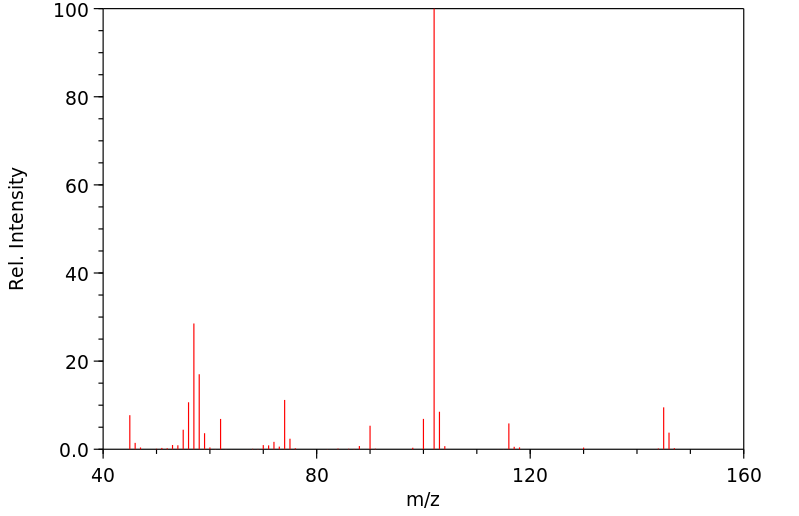丁胺甲酸乙酯 | 591-62-8
中文名称
丁胺甲酸乙酯
中文别名
——
英文名称
N-(ethoxycarbonyl)butylamine
英文别名
ethyl N-butylcarbamate;ethyl N-n-butylcarbamate;n-butylurethane;butyl-carbamic acid ethyl ester;Butyl-carbamidsaeure-aethylester;Kohlensaeure-aethylester-butylamid;ethyl N,N-n-butylcarbamate;ethyl butylcarbamate;N-Butyl-urethan
CAS
591-62-8
化学式
C7H15NO2
mdl
MFCD00027173
分子量
145.202
InChiKey
BQBKYSPXQYHTIP-UHFFFAOYSA-N
BEILSTEIN
——
EINECS
——
-
物化性质
-
计算性质
-
ADMET
-
安全信息
-
SDS
-
制备方法与用途
-
上下游信息
-
文献信息
-
表征谱图
-
同类化合物
-
相关功能分类
-
相关结构分类
物化性质
-
熔点:-22°C
-
沸点:228.04°C (estimate)
-
密度:0.9434
计算性质
-
辛醇/水分配系数(LogP):1.6
-
重原子数:10
-
可旋转键数:5
-
环数:0.0
-
sp3杂化的碳原子比例:0.857
-
拓扑面积:38.3
-
氢给体数:1
-
氢受体数:2
安全信息
-
海关编码:2924199090
SDS
上下游信息
-
上游原料
中文名称 英文名称 CAS号 化学式 分子量 N,N-二丁基氨基甲酸乙酯 ethyl N,N-di-n-butylcarbamate 2217-88-1 C11H23NO2 201.309 N-乙酰基氨基甲酸乙酯 ethyl acetylcarbamate 2597-54-8 C5H9NO3 131.131 -
下游产品
中文名称 英文名称 CAS号 化学式 分子量 —— butyl-carbamic acid-(2-diethylamino-ethyl ester) 92902-29-9 C11H24N2O2 216.324
反应信息
-
作为反应物:参考文献:名称:Bowen, Richard D.; Harrison, Alex G.; Reiner, Eric J., Journal of the Chemical Society. Perkin transactions II, 1988, p. 1009 - 1014摘要:DOI:
-
作为产物:描述:二正丁胺 以85%的产率得到丁胺甲酸乙酯参考文献:名称:Production of urethane compounds摘要:一种生产聚氨酯化合物的方法,该方法包括在催化剂系统存在下,将至少一种从主要由一级胺、二级胺和尿素化合物组成的组中选择的化合物与一氧化碳和有机羟基化合物反应,该催化剂系统包括:(a)至少一种从由铂族金属和含有至少一种铂族元素的化合物组成的组中选择的成员;以及 (b)至少一种从由碱金属或碱土金属卤化物、铵卤化物、能够形成铵卤化物的化合物、卤素原子的氧酸及其盐、含有卤素离子的络合物、有机卤化物和卤素分子组成的组中选择的含卤素化合物,在分子氧和/或有机硝基化合物作为氧化剂的条件下,在温度约为80℃至约300℃范围内,压力约为1 Kg/cm²至约500 Kg/cm²的条件下进行。公开号:US04621149A1
文献信息
-
[EN] PRODRUGS OF MYELOPEROXIDASE INHIBITORS<br/>[FR] PROMÉDICAMENTS D'INHIBITEURS DE LA MYÉLOPEROXYDASE申请人:BIOHAVEN THERAPEUTICS LTD公开号:WO2021072140A1公开(公告)日:2021-04-15Disclosed are prodrugs of myeloperoxidase (MPO) inhibitors, methods of treating MPO related disorders, e.g., multiple system atrophy, amyotrophic lateral sclerosis, and Huntingtons disease, and methods of neuroprotection, which include administering to a patient in need thereof the prodrugs, pharmaceutical compositions including the prodrugs, and kits including the pharmaceutical compositions and instructions for use.
-
A Novel PdCl2/ZrO2–SO2−4 Catalyst for Synthesis of Carbamates by Oxidative Carbonylation of Amines作者:Feng Shi、Youquan Deng、Tianlong SiMa、Hongzhou YangDOI:10.1006/jcat.2001.3350日期:2001.10At 170°C and ca. 4.0 MPa, oxidative carbonylation of aromatic amines to synthesize corresponding carbamates over a novel PdCl2/ZrO2–SO2−4 catalyst could proceed with high conversion and selectivity.在170°C和 4.0兆帕,芳族胺的氧化羰基化,以在新颖的PdCl合成相应的氨基甲酸酯2 /的ZrO 2 -SO 2- 4催化剂可以以高转化率和选择性进行。
-
A Simple Method for the Synthesis of Carbamates作者:Enrique Angeles、Abraham Santillán、Ignacio Martínez、Alberto Ramírez、Enrique Moreno、Manuel Salmón、Roberto MartínezDOI:10.1080/00397919408010552日期:1994.9Abstract A new method for carbamate synthesis using aryl and alkylamines with sodium hydride and diethylcarbonate in dry benzene is described.
-
Catalytic Activity of MCM-41–TBD in the Selective Preparation of Carbamates and Unsymmetrical Alkyl Carbonates from Diethyl Carbonate作者:Silvia Carloni、Dirk E. De Vos、Pierre A. Jacobs、Raimondo Maggi、Giovanni Sartori、Raffaella SartorioDOI:10.1006/jcat.2001.3439日期:2002.1The synthesis of carbamates 3 and unsymmetrical alkyl carbonates 5 by reaction of diethyl carbonate with aliphatic amines or alcohols has been realized by using as heterogeneous catalyst a hybrid organic–inorganic material prepared by anchoring TBD to MCM-41 silica. Products are obtained in high yield and very good selectivity and the solid catalyst can be recovered simply by filtration and reused
-
Structure–activity relationships of a small-molecule inhibitor of the PDZ domain of PICK1作者:Anders Bach、Nicolai Stuhr-Hansen、Thor S. Thorsen、Nicolai Bork、Irina S. Moreira、Karla Frydenvang、Shahrokh Padrah、S. Brøgger Christensen、Kenneth L. Madsen、Harel Weinstein、Ulrik Gether、Kristian StrømgaardDOI:10.1039/c0ob00025f日期:——Recently, we described the first small-molecule inhibitor, (E)-ethyl 2-cyano-3-(3,4-dichlorophenyl)acryloylcarbamate (1), of the PDZ domain of protein interacting with Cα-kinase 1 (PICK1), a potential drug target against brain ischemia, pain and cocaine addiction. Herein, we explore structureâactivity relationships of 1 by introducing subtle modifications of the acryloylcarbamate scaffold and variations of the substituents on this scaffold. The configuration around the double bond of 1 and analogues was settled by a combination of X-ray crystallography, NMR and density functional theory calculations. Thereby, docking studies were used to correlate biological affinities with structural considerations for ligandâprotein interactions. The most potent analogue obtained in this study showed an improvement in affinity compared to 1 and is currently a lead in further studies of PICK1 inhibition.
表征谱图
-
氢谱1HNMR
-
质谱MS
-
碳谱13CNMR
-
红外IR
-
拉曼Raman
-
峰位数据
-
峰位匹配
-
表征信息
同类化合物
(甲基3-(二甲基氨基)-2-苯基-2H-azirene-2-羧酸乙酯)
(±)-盐酸氯吡格雷
(±)-丙酰肉碱氯化物
(d(CH2)51,Tyr(Me)2,Arg8)-血管加压素
(S)-(+)-α-氨基-4-羧基-2-甲基苯乙酸
(S)-阿拉考特盐酸盐
(S)-赖诺普利-d5钠
(S)-2-氨基-5-氧代己酸,氢溴酸盐
(S)-2-[[[(1R,2R)-2-[[[3,5-双(叔丁基)-2-羟基苯基]亚甲基]氨基]环己基]硫脲基]-N-苄基-N,3,3-三甲基丁酰胺
(S)-2-[3-[(1R,2R)-2-(二丙基氨基)环己基]硫脲基]-N-异丙基-3,3-二甲基丁酰胺
(S)-1-(4-氨基氧基乙酰胺基苄基)乙二胺四乙酸
(S)-1-[N-[3-苯基-1-[(苯基甲氧基)羰基]丙基]-L-丙氨酰基]-L-脯氨酸
(R)-乙基N-甲酰基-N-(1-苯乙基)甘氨酸
(R)-丙酰肉碱-d3氯化物
(R)-4-N-Cbz-哌嗪-2-甲酸甲酯
(R)-3-氨基-2-苄基丙酸盐酸盐
(R)-1-(3-溴-2-甲基-1-氧丙基)-L-脯氨酸
(N-[(苄氧基)羰基]丙氨酰-N〜5〜-(diaminomethylidene)鸟氨酸)
(6-氯-2-吲哚基甲基)乙酰氨基丙二酸二乙酯
(4R)-N-亚硝基噻唑烷-4-羧酸
(3R)-1-噻-4-氮杂螺[4.4]壬烷-3-羧酸
(3-硝基-1H-1,2,4-三唑-1-基)乙酸乙酯
(2S,4R)-Boc-4-环己基-吡咯烷-2-羧酸
(2S,3S,5S)-2-氨基-3-羟基-1,6-二苯己烷-5-N-氨基甲酰基-L-缬氨酸
(2S,3S)-3-((S)-1-((1-(4-氟苯基)-1H-1,2,3-三唑-4-基)-甲基氨基)-1-氧-3-(噻唑-4-基)丙-2-基氨基甲酰基)-环氧乙烷-2-羧酸
(2S)-2,6-二氨基-N-[4-(5-氟-1,3-苯并噻唑-2-基)-2-甲基苯基]己酰胺二盐酸盐
(2S)-2-氨基-N,3,3-三甲基-N-(苯甲基)丁酰胺
(2S)-2-氨基-3-甲基-N-2-吡啶基丁酰胺
(2S)-2-氨基-3,3-二甲基-N-(苯基甲基)丁酰胺,
(2S)-2-氨基-3,3-二甲基-N-2-吡啶基丁酰胺
(2S,4R)-1-((S)-2-氨基-3,3-二甲基丁酰基)-4-羟基-N-(4-(4-甲基噻唑-5-基)苄基)吡咯烷-2-甲酰胺盐酸盐
(2R,3'S)苯那普利叔丁基酯d5
(2R)-2-氨基-3,3-二甲基-N-(苯甲基)丁酰胺
(2-氯丙烯基)草酰氯
(1S,3S,5S)-2-Boc-2-氮杂双环[3.1.0]己烷-3-羧酸
(1R,5R,6R)-5-(1-乙基丙氧基)-7-氧杂双环[4.1.0]庚-3-烯-3-羧酸乙基酯
(1R,4R,5S,6R)-4-氨基-2-氧杂双环[3.1.0]己烷-4,6-二羧酸
齐特巴坦
齐德巴坦钠盐
齐墩果-12-烯-28-酸,2,3-二羟基-,苯基甲基酯,(2a,3a)-
齐墩果-12-烯-28-酸,2,3-二羟基-,羧基甲基酯,(2a,3b)-(9CI)
黄酮-8-乙酸二甲氨基乙基酯
黄荧菌素
黄体生成激素释放激素(1-6)
黄体生成激素释放激素 (1-5) 酰肼
黄体瑞林
麦醇溶蛋白
麦角硫因
麦芽聚糖六乙酸酯
麦根酸







